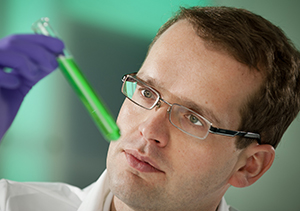Inhibiting and Detecting Pathogens with Nanoscience
 In the past century huge improvement in public health were gained through the development of antibiotics – however due to overuse resistance has developed, meaning new, disruptive technologies are urgently required.
In the past century huge improvement in public health were gained through the development of antibiotics – however due to overuse resistance has developed, meaning new, disruptive technologies are urgently required.
A key mechanism by which pathogens infect humans is by either adhering to cell surface carbohydrate (sugars) or by secreting toxins, which bind to these carbohydrates. The ability to mimic these surfaces offers potential to develop new biosensors or prophylactic therapies, which will be discussed here.
We have developed synthetic polymers (plastics) displaying cell-mimetic carbohydrates and shown these to be highly effective inhibitors of the Cholera toxin; there are 3 – 5 million cases of cholera poisoning per annum, and over 100,000 deaths per year. This simple approach removes the need for antibioitics, and should not induce evolutionary resistance.
Using a related approach, the carbohydrates have been installed into nanobiosensors which give a simple colour change, readable by eye or a mobile phone, when a particular pathogen is present. By tuning the surface chemistry of the nanoparticles, an ultra rapid and specific response can be generated in less than five minutes making it ideal for low-resource, point of care diagnostics to address the spread of infection in the developing world.
Matt Gibson
Matt was born and raised in Stockport in the North West of England, attending Hazel Grove High, and then Aquinas RC sixth form college. In 1999 Matt read Chemistry at the University of Durham as a member of Collingwood College, receiving a 1st Class Honours MChem in 2003. Inspired by his Masters research project (with Dr Lian Hutchings) Matt embarked on a PhD with Professor Neil Cameron, producing the Thesis "Synthesis and Characterisation of Novel Polypeptide Materials by the Polymerisation of NCAs".
In 2007 Matt received his PhD and packed his bags to move to the shores of Lake Geneva, Switzerland to begin a post-doc at the Ecole Polytechnique federale de Lausanne, with Professor Harm-Anton Klok. In between skiing, hiking and fondue, Matt found time to conduct his research on nanoparticle delivery technology. Matt was also heavily involved in the EU-wide Nanobiopharmaceutics consortium and acted as a workpackage leader for 2.5 years. Then, at the tender age of 29, Matt was appointed as a Birmingham Science City Interdisciplinary (SCIRA) Research Fellow, based in the Department of Chemistry at the University of Warwick.
He was subsequently promoted to a senior research fellowship (2011) and then assistant professor (2012). The Gibson Group currently consists of eight PhD students, one PDRA and several Masters-level students.
